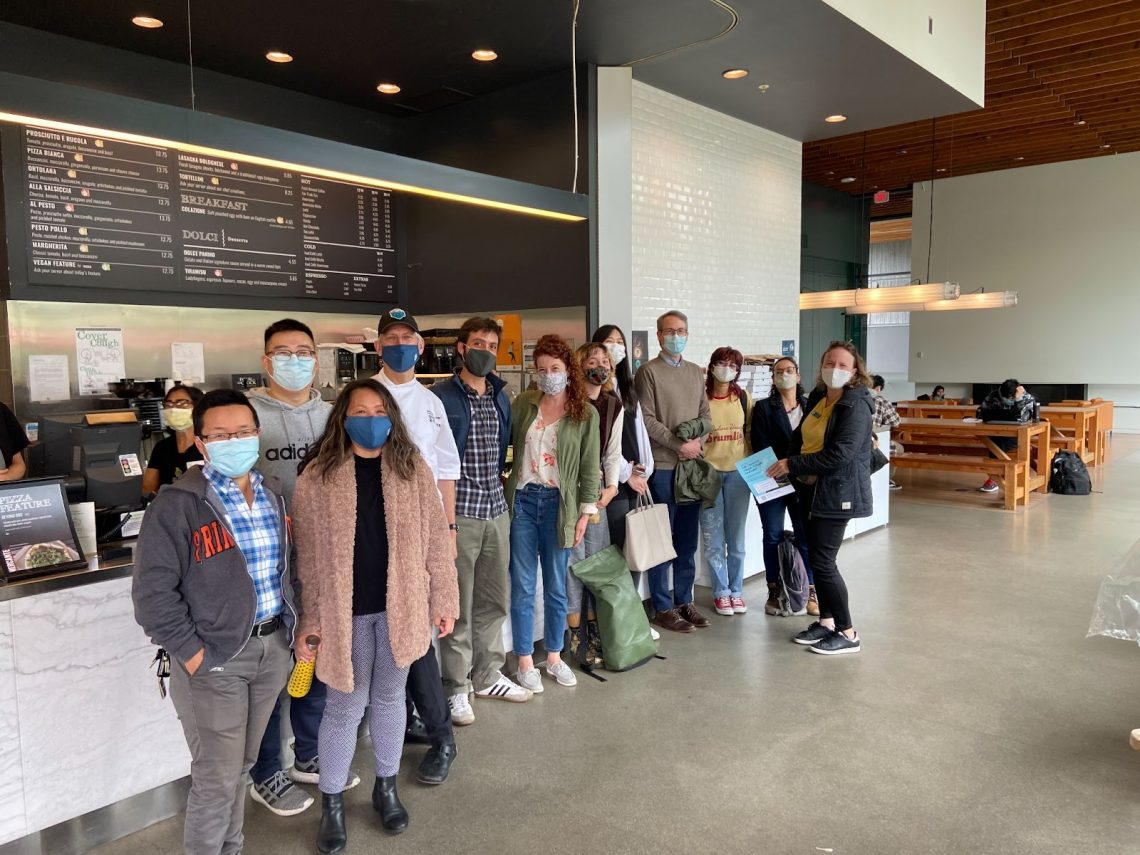This innovative multi-actor project was made possible thanks to the skills, passion, and commitment of the students and faculty members through a strong collaboration with Food Services supported by the Climate-Friendly Food System Action Team, working over the past years to develop, pilot and evaluate UBC’s first Climate-Friendly Food System (CFFS) Label in food outlets across UBC campus.
UBC aims to operate a climate-friendly, just and accessible food system which means reducing our GHG food systems footprint through food production, procurement, provision, consumption, waste and recovery.
Thanks to a novel methodology developed by on of the Research team, they were able to assess greenhouse (GHG) emissions, nitrogen, and water footprint associated with UBC’s food dining halls 1655 recipes during the pilot to evaluate and inform the “climate-friendliness” of food.
Why it is crucial to create a Climate-Friendly Food System at UBC?
From a global perspective, food systems are an enormous driver of climate change and contribute to more than one-third of global GHG emissions equivalent to around 34% of emission.
Based on UBC’s overall emissions (Scope 1, 2, and 3), food emissions represent 21% of UBC’s overall emissions for 2019, accounting for over 29,000 tCO2e per year. Based on UBC’s extended impact (scope 3 emissions), food emissions represent 31% of these emissions and are the second-highest after commuting. It is anticipated that food emissions may become UBC’s largest emissions category as other sources of UBC GHGs emissions reduce.
In an effort to tackle this, UBC’s Climate Action Plan 2030 has set a target to achieve a 50% reduction in food systems emissions by 2030 (on a 2019 baseline).
How do we determine what foods are climate-friendly?
The GHG emissions, nitrogen, and water footprints of each menu item are calculated by summing up the weight of every raw ingredient multiplied by their respective footprint factors. Ingredient footprint factors are determined according to their category in the Cool Food Calculator, which provides data on the amount of GHGs emitted during the food item’s life cycle (production, distribution, processing but excluding cooking emissions and associated food waste). Following UBC’s Climate Action Plan reduction goals for food systems, the Climate-Friendly Food Label was assigned to menu items whose composite footprint is 50% of the baseline in 2019.
The nitrogen footprint factors were provided by the Food label toolkit from Allision Leach (2016), and the water footprint factors are publicly available (Poore & Nemecek (2018)). The nitrogen and water footprint factors were recalculated for each food category in the GHG emissions factors list to maintain consistency and improve calculation efficiency.
This project has been led by the SEEDS Sustainability Program, which catalyzes student-led applied research and interdisciplinary partnerships to advance climate action at UBC. This project is in partnership with UBC Food Services, UBC’s Climate-Friendly Food System (CFFS) Action Team, Vancouver School of Economics (UBC Faculty of Arts), Department of Statistics (UBC Faculty of Science), Department of Psychology and the Institute for Resources, Environment and Sustainability.
Student perspectives
Silvia Huang supervised by Juan Diego Martinez have done outstanding work and most of the heavy lifting to build the framework and assessment methodology that allow the data team to evaluate UBC Food Services menu ingredients to attribute a Climate-Friendly impact score on it.
Silvia and Juan played integral roles in advancing the CFFS Label.


Silvia Huang’s perspective
Graduated from UBC with a bachelor’s degree in Economics and Statistics, in autumn 2022, Silvia will begin a master’s degree in analytics at the University of Chicago next September.
Silvia aims to pursue a career in data science and analytics to find and execute solutions to overcome challenges brought by the increasingly digital world.
She was enrolled in the UBC Science Co-op program and chose the Climate-Friendly Food System (CFFS) Label project as her first co-op job.
This project’s goal aligns with her own interest in using data to make a social impact. She was ecstatic to be in charge of building a data analysis framework from the ground up, which was a huge challenge that greatly improved her problem-solving and teamwork abilities.
Silvia work for the CFFS Label project as a data analyst. Her main responsibility has been to build an evaluation framework that can automate the evaluation process and perform life cycle analysis for large-scale recipes’ data.
The Climate-Friendly Food System (CFFS) Label impact according to Silvia
“The CFFS Label is a simple and effective method of indicating the climate-friendliness of meals that students buy on a daily basis. Students would be able to learn more about the food they eat and make more climate-friendly meal choices if we could provide more information behind the CFFS Label, such as the CFFS attributes data and their impact on climate.”
Her goal for the CFFS Label was to create a standardized method of menu item assessment and labeling criteria that can be used by universities and institutions across North America. According to Silvia:
“The most interesting aspect of working with SEEDS Sustainability Program is learning how people from different backgrounds and expertise can work together towards the same goal, promoting the Climate-Friendly Food Systems at UBC. Therefore, I learned to approach problems from different angles and come up with different solutions. This also poses some challenges, such as how to solve problems while meeting the needs of each team member and client.”
Aside from the interpersonal skills Silvia quickly developed, working with SEEDS Sustainability Program allows her to see things from a bigger picture that does not only focus on what she does but also from the perspective of a large team.
More information: Climate-Friendly Food Labels | UBC Sustainability
More questions about the project? Please send an email to seeds.info@ubc.ca

Leave a Reply